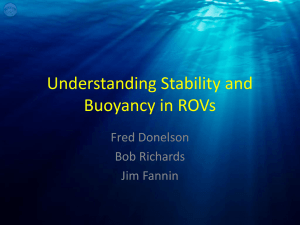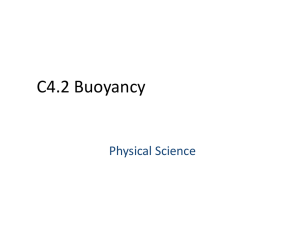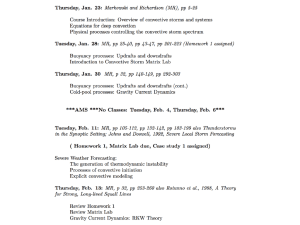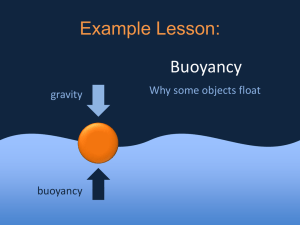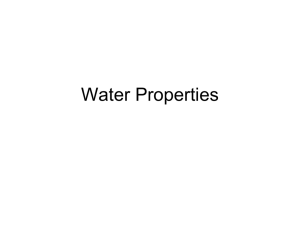Fluids Unit Density & Buoyancy
advertisement
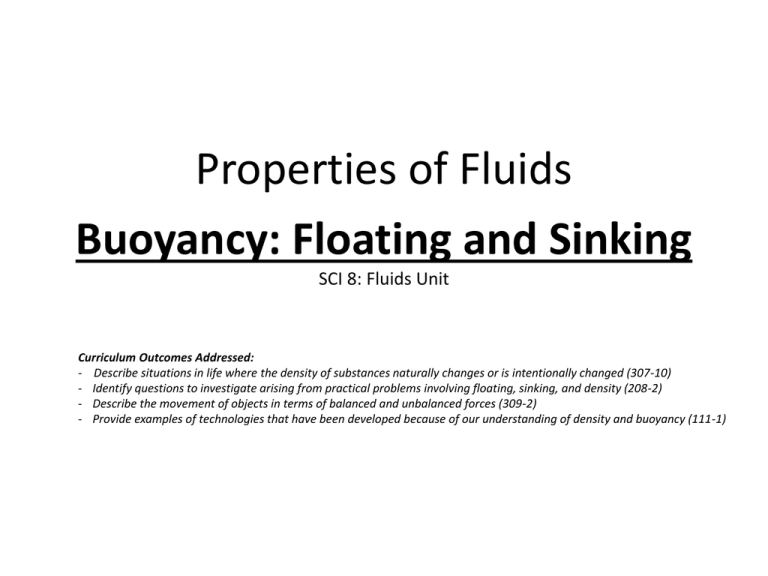
Properties of Fluids Buoyancy: Floating and Sinking SCI 8: Fluids Unit Curriculum Outcomes Addressed: - Describe situations in life where the density of substances naturally changes or is intentionally changed (307-10) - Identify questions to investigate arising from practical problems involving floating, sinking, and density (208-2) - Describe the movement of objects in terms of balanced and unbalanced forces (309-2) - Provide examples of technologies that have been developed because of our understanding of density and buoyancy (111-1) • We will study the following properties of fluids: 1. Density 2. Buoyancy (Floating and Sinking) 3. Displacement (Archimedes’ Principle) 4. Viscosity 5. Pressure (Pascal’s Principle) Key Terms • Buoyancy: The upward force on an object submersed in a liquid • Gravity: The downward force on an object Floating and Sinking: Density • Whether an object floats or sinks is dependent on the object’s density compared to the density of the liquid in which it is immersed. • If the density of the object is greater than the density of the liquid in which it is immersed, then the object will sink. • If the density of the object is less than the density of the liquid in which it is immersed, then the object will float. Floating and Sinking: Buoyancy • The relationship between the object’s density and the liquid’s density in which it is immersed affects the force of buoyancy acting on the object. This is what causes the object to either float or sink in the given liquid. • If the object has a greater density than the liquid, then the gravitational force pulling down on the object is greater than the buoyant force pushing up, which causes the object to sink. • If the object’s density is less than that of the liquid, then the buoyant force will be greater than the gravitational force pulling down, causing the object to float. The Forces at Work in Buoyancy • Gravitational force “pulling” down • Buoyant force “pushing” up If the buoyant push upward is greater than the gravitational pull downward, then the object will float (if the object’s density is greater than the density if the liquid in which it is) …and vice versa. Three Types of Buoyancy • Negative Buoyancy: Object sinks (Gravitational “down” force is greater than buoyant “up” force – object’s density is greater than that of the fluid in which it is immersed) • Neutral Buoyancy: Object is suspended in middle (Gravity and buoyancy are equal – same densities) • Positive Buoyancy: Object floats (Buoyant “up” force is greater than the gravitational “down” force – object’s density is less than that of the fluid in which it is immersed) POSITIVE BUOYANCY NEUTRAL BUOYANCY NEGATIVE BUOYANCY Virtual Floating and Sinking Lab Why do Things Float? http://glencoe.mcgraw-hill.com/sites/0078741858/student_view0/unit1/chapter3/virtual_labs.html# Altering Buoyancy in Everyday Life • Buoyancy can be altered (changed) if necessary. • Some examples are in which this happens, are: i. Scuba divers ii. Submarine iii. Fish i. Scuba Divers – Weight Belt and BCD • Scuba divers wear weight belts so that they are more dense, allowing them dive downwards more easily. • Scuba divers also wear a buoyancy compensator (also known as a “buoyancy control device”, or BCD). The BCD is a vest/jacket that contains a ‘bladder’ to help alter buoyancy. The buoyancy is controlled by adjusting the volume of air in the bladder. When the divers need to become less dense (to rise), they let air into the bladder. To become more dense (to sink or remain neutrally buoyant), they pump air out of the BCD. BCD Weight Belt ii. Submarine – Ballast Tank • Ballasts act as weight and alter buoyancy. Tanks of water act as ballasts on submarines. • Changing the amount of water in the ballast tank of a submarine allows a submarine sink or rise. In order to sink (become more dense), the ballast tank is filled with water. In order to rise (become less dense), the water is pumped back out and is replaced by air. Practice Questions 1) Object A has a greater density than the liquid in which it is immersed. Will object A sink or float in this liquid? 2) Object B’s density is smaller than the density of the liquid. Will object B sink or float in this liquid? 3) Object C’s density is the same as that of the liquid. What happens to this object? Practice Questions 4) When the buoyant force is greater than the gravitational force, the object ____________. 5) When the gravitational force is greater than the buoyant force, the object ________________. 6) When the gravitational and buoyant forces are equal in strength, what happens to the object? Density & Buoyancy Lab Activity Boat Building Challenge
